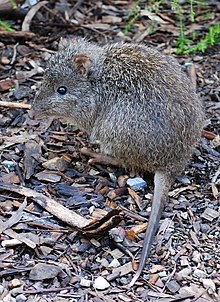Long-nosed potoroo
| Long-nosed potoroo | |
|---|---|
 |
|
| Scientific classification | |
| Kingdom: | Animalia |
| Phylum: | Chordata |
| Class: | Mammalia |
| Infraclass: | Marsupialia |
| Order: | Diprotodontia |
| Family: | Potoroidae |
| Genus: | Potorous |
| Species: | P. tridactylus |
| Binomial name | |
|
Potorous tridactylus (Kerr, 1792) |
|
| Subspecies | |
|
|
 |
|
| Distribution of the long-nosed potoroo | |
The long-nosed potoroo (Potorous tridactylus) is a species of Australian potoroo. These small marsupials are part of the rat-kangaroo family. The long-nosed potoroo contains two subspecies, P. t. tridactylus from Mainland Australia, and P. t. apicalis from Tasmania, which tends to have lighter fur than P. t. tridactylus. At first glance, the long-nosed potoroo with its pointed nose and grey-brown fur looks very much like a bandicoot — that is, until it hops away with its front feet tucked into its chest, revealing its close relationship with the kangaroo family. The long-nosed potoroo exhibits many morphological specializations such as an elongated pointed rostral region (nose), erect ears, large eyes, claws for digging, and long robust hind legs. It is only a small marsupial, with a body length between 34 and 38 cm (13–15 in), and a semi-prehensile tail length of 15 to 24 cm (5.9–9.4 in).
As it is rarely seen in the wild, better indicators of its presence are the runways it makes through the undergrowth and the hollow diggings it leaves behind when feeding on underground roots and fungi.
The long-nosed potoroo is found in a variety of macrohabitats located in the Southern Highlands of New South Wales and South-Western Victoria on the Australian mainland, and in Tasmania. Its bones have been found in a number of cave deposits, indicating it was once more widespread than it is today. This species prefers a range of vegetation types, from subtropical and warm temperate rainforest, through tall open forest with dense understorey, to dense coastal heaths. Its main requirement is thick groundcover, which it needs for protection and nesting material. It also prefers light soils that are easy to dig in for the underground roots and fungi that it eats.
Home-range sizes of the long-nosed potoroo vary considerably; the largest recorded was 34.4 hectares (85 acres). In Tasmania, large overlapping home ranges of 5–20 hectares (12–49 acres) have been recorded, with males typically acquiring more land than females. Home ranges in Victoria, however, are much smaller.
...
Wikipedia

